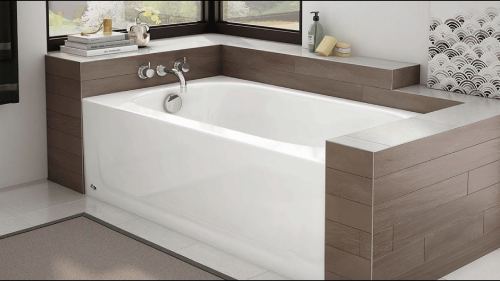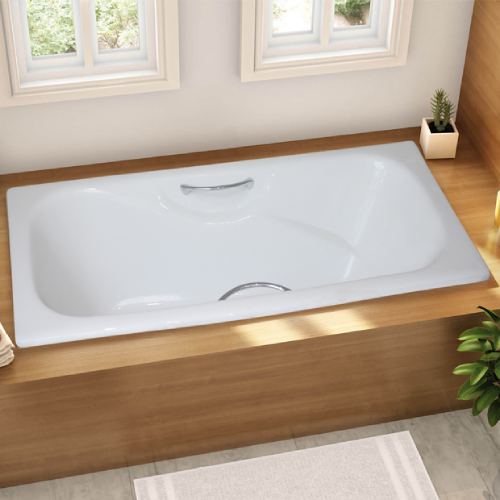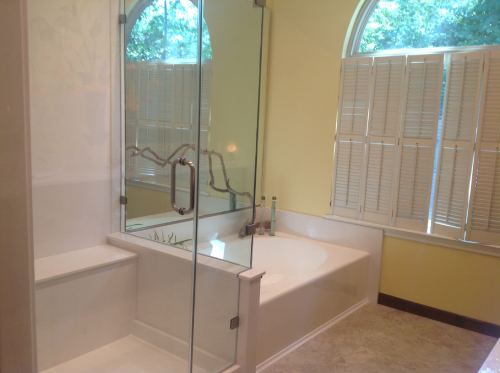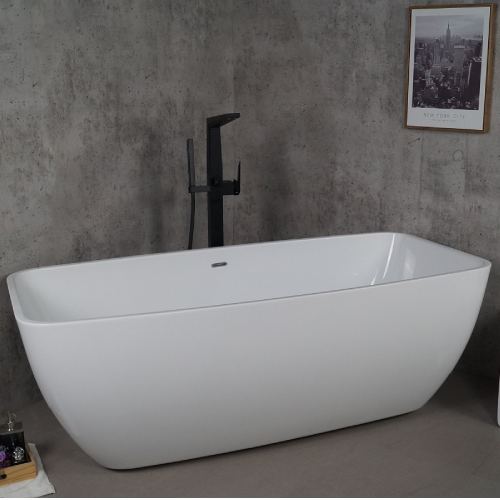When you take a bath, everything must be at its best. The bathroom should be neat and clean, the tub must not be rusty, the water temperature should be warm, and your bathing essentials should also be convenient. Thus, there are a lot of things to be considered before buying a bathtub. That’s why it’s important to choose materials that can guarantee the quality of your bathing time.
Would you like to know the common bathtub materials that exist in the market? Just follow this article and you’re going to learn all of them.
Bathtub Material Comparison: A Simple Guide
There are many different bathtub materials, and it can sometimes be difficult to tell which one is right for you. When you’re looking for a new bathtub, there’s no need to get overwhelmed: here’s a simple guide to help you decide what material will work best for your space.
1. Porcelain Enameled Steel – Porcelain Enameled Steel is a common bathtub material that can be used in the bathroom shower or the kitchen. The steel is naturally resistant to rust and corrosion. This material offers a beautiful finish that you won’t grow tired of in years to come.
Pros: With porcelain enameled steel, you can expect to find something that is both affordable and durable. The steel is naturally resistant to rust and corrosion, allowing it to stand the test of time with relative ease. Additionally, it is available in a wide range of sizes and shapes, which means that it can be made to fit any bathroom or tub space.
Cons: Despite its affordability and durability, porcelain-enameled steel does have some drawbacks. It is not as visually appealing as other materials because of its tendency to show scratches and dents. It also cannot be refinished like other materials if it becomes damaged.

2. Enameled Cast Iron – Enameled cast iron is an ideal material for bathtubs because of its aesthetically pleasing glossy surface and built-in versatility. The enamel finish comes in a range of colors to blend seamlessly with any bathroom, from bright white to dark black. What’s more, the enamel is highly resilient and non-porous, impervious to most chemicals, stains, and scratches. And because it’s so durable and retains heat well, enameled cast iron provides performance unmatched by other materials.
Pros: This material is heavy and sturdy, it absorbs heat, it retains heat for longer periods of time, it comes in different colors you can select from, and it’s durable and very easy to clean.
Cons: It’s the most expensive bathtub material, It’s very heavy therefore it may require professional help to install, but it is difficult to repair in case of damage due to its weight.

3. Acrylic – Acrylic is a durable and versatile material used in all kinds of products, from bathtubs to shower walls. It’s made of poly (methyl methacrylate) and formed by mixing with colorants and mold retardants, which are partially responsible for its properties. Acrylics are some of the safest plastics available and they’re easy to maintain.
Pros: Acrylic is a synthetic material that’s used in all kinds of products, from tubs to shower walls. It’s smooth and easy to clean, and it holds heat well-meaning it can help keep your bathwater nice and warm while you bathe. Acrylic baths are also cheaper than other options on the market.
Cons: While acrylic is quite strong when it’s new, over time it can become brittle or crack. Its surface is easy to age, the acrylic bathtub surface that uses for above 3 years rarely maintains its original color.

4. Cast Polymer – Cast polymer is a bathtub material used to create a durable, long-lasting product that is as cost-efficient as a fiberglass tub. The bathtub is easy to clean and maintain while providing a smooth surface on the bottom of each bathtub.
Pros: High durability, high heat retention, inexpensive, easy to clean and maintain, great design flexibility, quiet and comfortable
Cons: Can be damaged by direct exposure to sunlight or heat sources, cosmetic repairs can be challenging, heavy, and difficult to install. It can also turn to be brittle as time passed.

5. Fiberglass – Fiberglass bathtubs are made of epoxy resin and fiberglass. The material is durable, lightweight, easy to install and replace, inexpensive, and provides a seamless visual appearance.
Pros: Fiberglass tubs are one of the most popular options for homeowners because they’re easy to install, durable, and inexpensive. They’re also lightweight and easy to move around if you need to replace them.
Cons: Fiberglass tubs can be prone to scratching, so be careful not to drop any heavy items on them. You should also avoid using abrasive cleaners on your fiberglass tubs.

Things to Consider in Choosing a Bathtub Material for your Bathroom
Choosing the right bathtub material is a big decision. You want something that is cost-effective, long-lasting, easy to install, and one that will give you many years of enjoyment. It’s important to understand these before making your choice.
1. Price
One of the most significant factors when choosing a bathtub material is cost. The material you choose will have an impact on your budget; however, it shouldn’t be the only factor taken into consideration.
2. Weight
Weight is also something you should consider when choosing a bathtub material. Many people assume that heavier materials are better quality and more durable than lighter ones, but this isn’t always true.
3. Bathtub Life
The life expectancy of your tub depends on several factors including how often it gets used and whether or not you have children who play games in there with lots of water splashing around! The best way to determine which material would suit your needs best is by talking to someone who knows what they’re talking about at home improvement stores or online forums.
We hope this article will help you to choose the right bathtub. Good luck!
Frequently Asked Questions about Bathtub Materials:
It depends on personal preferences and needs. Some people prefer acrylic bathtubs because they’re easy to clean and maintain, while others might prefer cast iron bathtubs for their durability.
Bathtubs can exist for 10-30 years, depending on the type of bathtub material. Acrylic and fiberglass tubs are more likely to last 10-15 years. A porcelain-enameled cast-iron tub may survive much longer, but it will require refinishing every 5-15 years.
0 Comments for “Five Common Bathtub Materials Create Your Top Bathroom Enjoyment”